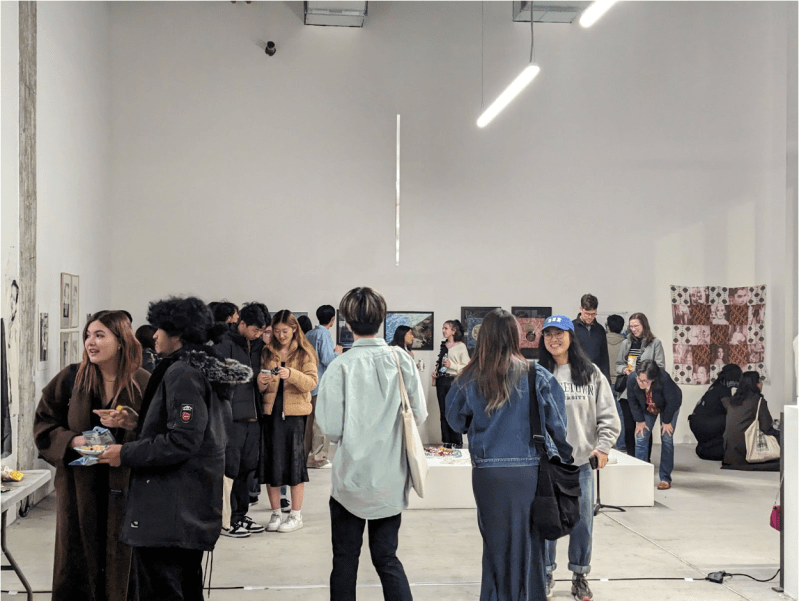Editor’s Note: This article is a review and includes subjective thoughts, opinions and critiques.
Amid the sounds of vibrant live music and winter evening rain, crowds of Bay Area art enthusiasts and students mingled at Oakland’s Good Mother Studio this weekend. In a partnership with student organization ArtX, the works of over 35 student artists were exhibited at the gallery in one of the largest ever off-campus shows exclusively featuring artwork by Stanford students.
The pop-up, titled “One More Time,” featured a dazzling array of paintings, sculptures and live performance art. The show was the brainchild of L. Song Wu ’24, a prolific Stanford student artist and financial officer for ArtX who met the Good Mother Studio’s owners last fall at the Oakland venue’s inaugural show, “Hopelessly Devoted.” Wu pitched the idea of a Stanford student art show to the gallery’s owners, and together they brought the event to life.
Wu said her goal with the pop-up was to “bring Stanford students into the context of the larger Bay Area,” helping them connect with an artistic community beyond the “Stanford bubble.”
“When I was a freshman, I knew that I wanted to be an artist and that I always wanted a space like this,” Wu said. “I didn’t realize that making it happen wasn’t actually that hard.”
The show’s opening reception, which took place on Saturday, started on an energetic note with two spoken word performances. In her poem “Tables,” Ariana Lee ’27 delivered a thoughtful meditation on womanhood and female solidarity through clever wordplay.
“Someone once told me that women of color are more likely to use diminutive words / Such as just and sorry and might,” Lee narrated. “But for a more just world women taught me to not say sorry / When using my might.”
Kylan Denney ’27 similarly explored the boundaries of language in her spoken word piece “Who Brings a Poem to a Gun Fight?” In the piece, Denney questioned the power of words to remedy social injustices, captivating the venue with a voice that alternated between passionate conviction and heart-rending vulnerability.
The visual arts pieces on display also used their respective mediums in inventive ways to explore ideas of artistic voice and cultural identity. I was particularly struck by pieces like Lily Thai’s ‘27 “Áo Dài in Seven Parts,” which used a deconstructed piece of Vietnamese traditional dress as a canvas for a series of intimate family portraits.
Victoria Lin’s ’27 acrylic painting “Black Friday” tackled the subject of family from an entirely different angle, depicting the artist and her family engaged in a frantic shopping expedition with comically bright hues and an infectious sense of energy.
Displaying such a wide variety of art pieces next to each other, from pen-and-ink drawings to wall projections of short films, could have risked looking chaotic — but the show’s curators did an impressive job ensuring the placement of each work flowed cohesively to the next. A large cut-out of a vivid pink rabbit hung above the exhibit, tying the scene together with a whimsical, Wonderland-esque feel.
Wu said she did not choose a central theme for the pieces featured in “One More Time” in order to avoid stifling the creative expression of Stanford artists.
“I just think that people should submit the best work that they possibly can,” Wu said. “My hope is that when the artwork is good, [the pieces] will have a conversation with each other.”
When I first arrived at the studio, I was confused about why none of the pieces displayed had signs with the artists’ names or the titles of their work. However, I soon noticed lively conversations picking up around me as students excitedly approached each other to ask questions about one another’s art pieces. Whether intended or not, the lack of descriptive signs served as an invitation for artists and gallery visitors to talk to one another to learn about the inspiration behind each piece.
This proved to be a rewarding experience for student artists like Lin. “Being a part of the gallery opened up opportunities to connect with other artists and performers who I wouldn’t have been likely to meet on campus,” Lin wrote.
The enthusiasm that Stanford students brought to the show was also a pleasant surprise for gallery co-owner Jared Jethmal. “It was exciting for us to see the work that’s coming out of Stanford, and it was really kind of an honor for us to house it,” Jethmal said.
If there is any overarching theme that I left the Good Mother Studio with, it was that “One More Time” was as much a celebration of the passion and versatility of Stanford’s artistic community as it was a showcase of the works themselves. This was especially poignant for Wu, who will soon be graduating from Stanford and leaving the on-campus art scene.
“The Stanford art community is really strong, and it’s important for us to show up for one another and venture out into the larger arts culture,” Wu said.
Stanford’s artists certainly showed up for each other at “One More Time.” Based on the overwhelming talent and sense of community I saw at the Good Mother Studio, it hopefully won’t be the last.
This article has been updated to reflect the correct title of Ariana Lee’s ’27 spoken word piece, “Tables.” The Daily regrets this error.
